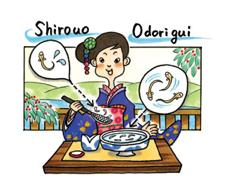Hakata Culture vol.35
The Fish Heralding Spring’s Arrival

Several flora and fauna herald the approach of spring in Fukuoka. These include the plum blossoms in Dazaifu and the arrival of the black-headed gull at the Naka River and Ohori Park. Yet another is the fish known as the ice goby. Every year from February to the beginning of April, the fish swims from Hakata Bay to locations near the mouth of the Muromi River, which empties into Hakata Bay at the border between Atagohama in Nishi Ward and Momochihama in Sawara Ward, where it spawns. Another sign of spring is the sight of fishermen using fencing, called yana, to surround and pen in the ice goby. The only spot of color on these five-centimeter-long, transparent gobies is the black part of the eye. Their flavor is as plain as their shape. One popular way of eating them is called odorigui. In this method, dozens of the fish are allowed to swim in a large and deep white bowl. They are scooped up in a net and swallowed whole with vinegared soy sauce.
The fish seem to dance in the mouth, or odoru in Japanese, which is how the method got its name. It is not that the fish is particularly delicious, but that the manner of eating it calls to mind the advent of spring. Other spring foods include broths, egg soup, and grilled oysters. These dishes can be eaten at restaurants near the mouth of the Muromi River, as well as small prefabricated huts set up for the season on the riverbank. A park was built on the banks of the Muromi River as a recreational area for the city’s residents, and it is used by many joggers and walkers. There are mudflats near the mouth of the river, and in the spring many people gather to hunt for shells at low tide. Despite the fact the Muromi River flows through the center of the city, it is home to the ice goby, shellfish, and more than 100 species of wild birds. The river is a treasure for Fukuoka City. It seems that with each passing year, the goby, shellfish, and birds are dwindling in number, but it is a natural environment that we should continue to protect.
A public relations manager
Kimiyo Sasaki
福岡に春が来たことを告げる魚
福岡に春が近いことを告げる風物詩に、太宰府の飛び梅、那珂川や大濠公園に飛来するユリカモメなどがありますが、もう一つが「白魚」です。西区愛宕浜と早良区百道浜の境界から博多湾に注ぐ川・室見川の河口付近に、毎年2月から4月初めにかけて博多湾から産卵のためにのぼってきます。それを「梁」と呼ばれる柵で囲い込んで漁をするシロウオ漁が早春の風物詩となっているのです。
体長は5センチほどの透明なハゼ科の小魚で目だけが黒い。姿に似て味も淡泊です。有名な食べ方は「シロウオの踊り喰い」。白く大きな深みのある皿に数十匹のシロウオを泳がせ、それを網ですくって酢じょうゆで噛まずにすすりこむという食べ方です。口の中で踊っているような感覚になるので、その名が付けられたようです。生きたまま食べるなんて残酷だと思われるかもしれませんが、この食べ方も春の訪れを告げるものだと考えてください。ほかにも、吸い物や卵とじ、かき揚げにしていただきます。
2月中旬くらいからは室見川の河口付近にある料理屋さんで食べさせてくれますし、この時期には河畔に臨時のプレハブ小屋が建てられて食べられるようになっています。
室見川は福岡市民の憩いの場として河畔公園が作られ、ジョギングや散歩ができるように整備されています。河口付近には干潟があるため、春になると潮干狩りをする人々も集まってきます。街の中を流れる川なのに、シロウオ漁、潮干狩り、そして毎年100種類を超える野鳥が集まってくる室見川。福岡市の宝だと思います。年々、シロウオもアサリ貝も野鳥の飛来も少なくなっているようですが、大切に守り続けていきたい自然環境です。
福岡市広報課長 佐々木 喜美代

